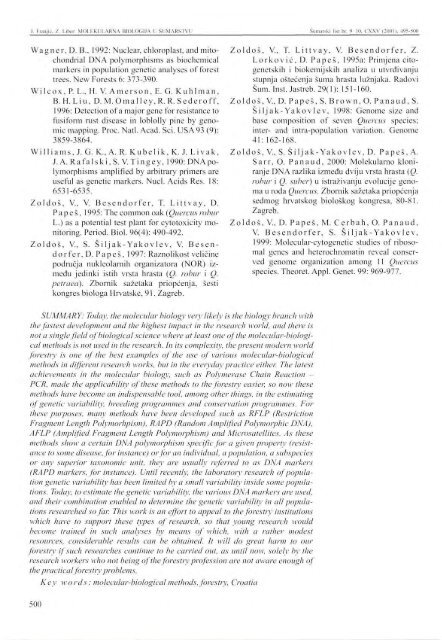You also want an ePaper? Increase the reach of your titles
YUMPU automatically turns print PDFs into web optimized ePapers that Google loves.
J. Kranjić, Z. Liber: MQI.KKL'LARNA BIOLOGIJA U ŠUMARSTVU Šumarski list br. 9 <strong>10</strong>, CXXV (<strong>2001</strong>). 495-500<br />
Wagner, D. B., 1992: Nuclear, chloroplast, and mitochondrial<br />
DNA polymorphisms as biochemical<br />
markers in population genetic analyses of forest<br />
trees. New Forests 6: 373-390.<br />
Wilcox, P. L., H. V. Amerson, E. G. Kuhlman,<br />
B. H. L i u, D. M. O m a 11 e y, R. R. S e d e r o f f,<br />
1996: Detection of a major gene for resistance to<br />
fusiform rust disease in loblolly pine by genomic<br />
mapping. Proc. Natl. Acad. Sci. USA 93 (9):<br />
3859-3864.<br />
Williams, J. G. K., A. R. Kubelik, K. J. Livak,<br />
J. A. Rafal ski, S.V. Tingey, 1990: DNA polymorphisms<br />
amplified by arbitrary primers are<br />
useful as genetic markers. Nucl. Acids Res. 18:<br />
6531-6535.<br />
Zoldoš, V., V. Besendorfer, T. Littvay, D.<br />
Papeš, 1995: The common oak (Quercus robur<br />
L.) as a potential test plant for cytotoxicity monitoring.<br />
Period. Biol. 96(4): 490-492.<br />
Zoldoš, V., S. Š ilj ak-Yako vl ev, V. Besendorfer,<br />
D. Papeš, 1997: Raznolikost veličine<br />
područja nukleolarnih organizatora (NOR) između<br />
jedinki istih vrsta hrasta (Q. robur i Q.<br />
petraea). Zbornik sažetaka priopćenja, šesti<br />
kongres biologa Hrvatske, 91. Zagreb.<br />
Zoldoš, V., T. Littvay, V. Besendorfer, Z.<br />
Lorković, D. Papeš, 1995a: Primjena citogenetskih<br />
i biokemijskih analiza u utvrđivanju<br />
stupnja oštećenja šuma hrasta lužnjaka. Radovi<br />
Šum. Inst. Jastreb. 29(1): 151-160.<br />
Zoldoš, V., D. Papeš, S. Brown, O. Panaud, S.<br />
Šilj ak-Yako vlev, 1998: Genome size and<br />
base composition of seven Quercus species;<br />
inter- and intra-population variation. Genome<br />
41: 162-168.<br />
Zoldoš, V., S. Siljak-Yakovlev, D. Papeš, A.<br />
Sarr, O. Panaud, 2000: Molekularno kloniranje<br />
DNA razlika između dviju vrsta hrasta (Q.<br />
robur i Q. suber) u istraživanju evolucije genoma<br />
u roda Quercus. Zbornik sažetaka priopćenja<br />
sedmog hrvatskog biološkog kongresa, 80-81.<br />
Zagreb.<br />
Zoldoš, V., D. Papeš, M. Cerbah, O. Panaud,<br />
V. Besendorfer, S. Siljak-Yakovlev,<br />
1999: Molecular-cytogenetic studies of ribosomal<br />
genes and heterochromatin reveal conserved<br />
genome organization among 11 Quercus<br />
species. Theoret. Appl. Genet. 99: 969-977'.<br />
SUMMARY: Today, the molecular biology very likely is the biology branch with<br />
the fastest development and the highest impact in the research world, and there is<br />
not a single field of biological science where at least one of the molecular-biological<br />
methods is not used in the research. In its complexity, the present modern world<br />
forestry is one of the best examples of the use of various molecular-biological<br />
methods in different research works, but in the everyday practice either. The latest<br />
achievements in the molecular biology, such as Polymerase Chain Reaction -<br />
PCR, made the applicability of these methods to the forestry easier, so now these<br />
methods have become an indispensable tool, among other things, in the estimating<br />
of genetic variability, breeding programmes and conservation programmes. For<br />
these purposes, many methods have been developed such as RFLP (Restriction<br />
Fragment Length Polymorhpism), RAPD (Random Amplified Polymorphic DNA),<br />
AFLP (Amplified Fragment Length Polymorphism) and Microsatellites. As these<br />
methods show a certain DNA polymorphism specific for a given property (resistance<br />
to some disease, for instance) or for an individual, a population, a subspecies<br />
or any superior taxonomic unit, they are usually referred to as DNA markers<br />
(RAPD markers, for instance). Until recently, the laboratory research of population<br />
genetic variability has been limited by a small variability inside some populations.<br />
Today, to estimate the genetic variability, the various DNA markers are used,<br />
and their combination enabled to determine the genetic variability in all populations<br />
researched so far. This work is an effort to appeal to the forestry institutions<br />
which have to support these types of research, so that young research would<br />
become trained in such analyses by means of which, with a rather modest<br />
resources, considerable results can be obtained. It will do great harm to our<br />
forestry if such researches continue to be carried out, as until now, solely by the<br />
research workers who not being of the forestry profession are not aware enough of<br />
the practical forestry problems.<br />
Key words: molecular-biological methods, forestry, Croatia<br />
500
















